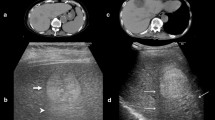Abstract
A consensus surveillance protocol is lacking for non-cirrhotic patients with hypervascular liver lesions presumed to represent hepatocellular adenomas. Patients with hypervascular liver lesions <5 cm not meeting criteria for focal nodular hyperplasia or hepatocellular carcinoma underwent surveillance with contrast-enhanced magnetic resonance imaging (MRI) 6, 12, and 24 months after baseline imaging. If lesions remained stable or decreased in size, then surveillance imaging was discontinued. Between 2011 and 2014, 116 patients with hypervascular liver lesions were evaluated. Seventy-nine patients were eligible for the surveillance protocol. Median follow-up was 24 months (range, 1–144 months). One patient (1 %) continued oral contraceptive pill (OCP) use and presented with hemorrhage requiring embolization 5 months after initial diagnosis. Ten patients (13 %) underwent elective embolization or surgical resection for size ≥5 cm. The remaining 68 patients (86 %) continued surveillance without hemorrhage or malignant transformation. Risk factors for requiring intervention during the surveillance period included younger age, larger lesion size, and estrogen use (all p < 0.05). Patients with hepatocellular adenomas <5 cm can safely be observed after discontinuing OCP with serial imaging 6, 12, and 24 months after diagnosis. If lesions remain stable or decrease in size, then longer-term surveillance is unlikely to identify patients at risk for complications.


Similar content being viewed by others
References
Chun YS, House MG, Kaur H, Loyer EM, Paradis V, Vauthey JN. SSAT/AHPBA joint symposium on evaluation and treatment of benign liver lesions. Journal of Gastrointestinal Surgery 2013;17:636–644.
Rooks JB, Ory HW, Ishak KG, Strauss LT, Greenspan JR, Hill AP, Tyler CW, Jr. Epidemiology of hepatocellular adenoma. The role of oral contraceptive use. JAMA 1979;242:644–648.
Bioulac-Sage P, Taouji S, Possenti L, Balabaud C. Hepatocellular adenoma subtypes: the impact of overweight and obesity. Liver International 2012;32:1217–1221.
Bunchorntavakul C, Bahirwani R, Drazek D, Soulen MC, Siegelman ES, Furth EE, Olthoff K, Shaked A, Reddy KR. Clinical features and natural history of hepatocellular adenomas: the impact of obesity. Alimentary Pharmacology & Therapeutics 2011;34:664–674.
Farges O, Dokmak S. Malignant transformation of liver adenoma: an analysis of the literature. Digestive Surgery 2010;27:32–38.
Dokmak S, Paradis V, Vilgrain V, Sauvanet A, Farges O, Valla D, Bedossa P, Belghiti J. A single-center surgical experience of 122 patients with single and multiple hepatocellular adenomas. Gastroenterology 2009;137:1698–1705.
Deneve JL, Pawlik TM, Cunningham S, Clary B, Reddy S, Scoggins CR, Martin RC, D’Angelica M, Staley CA, Choti MA, Jarnagin WR, Schulick RD, Kooby DA. Liver cell adenoma: a multicenter analysis of risk factors for rupture and malignancy. Annals of Surgical Oncology 2009;16:640–648.
Cho SW, Marsh JW, Steel J, Holloway SE, Heckman JT, Ochoa ER, Geller DA, Gamblin TC. Surgical management of hepatocellular adenoma: take it or leave it? Annals of Surgical Oncology 2008;15:2795–2803.
van Aalten SM, Terkivatan T, de Man RA, van der Windt DJ, Kok NF, Dwarkasing R, Ijzermans JN. Diagnosis and treatment of hepatocellular adenoma in the Netherlands: similarities and differences. Digestive Surgery 2010;27:61–67.
Karkar AM, Tang LH, Kashikar ND, Gonen M, Solomon SB, Dematteo RP, MI DA, Correa-Gallego C, Jarnagin WR, Fong Y, Getrajdman GI, Allen P, Kingham TP. Management of hepatocellular adenoma: comparison of resection, embolization and observation. HPB 2013;15:235–243.
Author information
Authors and Affiliations
Corresponding author
Rights and permissions
About this article
Cite this article
Chun, Y.S., Parker, R.J., Inampudi, S. et al. Imaging Surveillance of Hypervascular Liver Lesions in Non-Cirrhotic Patients. J Gastrointest Surg 20, 564–567 (2016). https://doi.org/10.1007/s11605-015-2942-9
Received:
Accepted:
Published:
Issue Date:
DOI: https://doi.org/10.1007/s11605-015-2942-9




